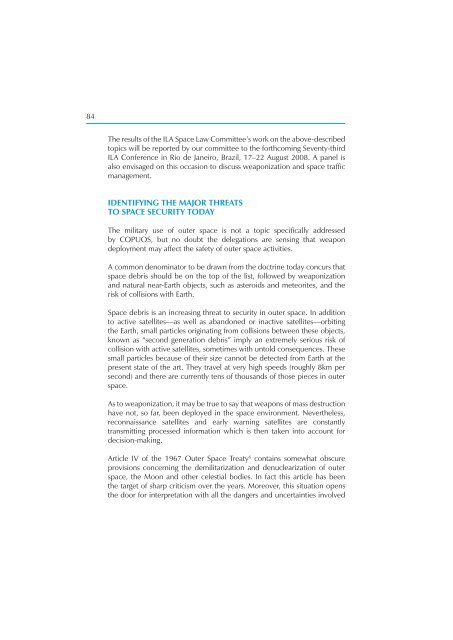Security in Space The Next Generation - UNIDIR
Security in Space The Next Generation - UNIDIR
Security in Space The Next Generation - UNIDIR
You also want an ePaper? Increase the reach of your titles
YUMPU automatically turns print PDFs into web optimized ePapers that Google loves.
84<br />
<strong>The</strong> results of the ILA <strong>Space</strong> Law Committee’s work on the above-described<br />
topics will be reported by our committee to the forthcom<strong>in</strong>g Seventy-third<br />
ILA Conference <strong>in</strong> Rio de Janeiro, Brazil, 17–22 August 2008. A panel is<br />
also envisaged on this occasion to discuss weaponization and space traffi c<br />
management.<br />
IDENTIFYING THE MAJOR THREATS<br />
TO SPACE SECURITY TODAY<br />
<strong>The</strong> military use of outer space is not a topic specifi cally addressed<br />
by COPUOS, but no doubt the delegations are sens<strong>in</strong>g that weapon<br />
deployment may affect the safety of outer space activities.<br />
A common denom<strong>in</strong>ator to be drawn from the doctr<strong>in</strong>e today concurs that<br />
space debris should be on the top of the list, followed by weaponization<br />
and natural near-Earth objects, such as asteroids and meteorites, and the<br />
risk of collisions with Earth.<br />
<strong>Space</strong> debris is an <strong>in</strong>creas<strong>in</strong>g threat to security <strong>in</strong> outer space. In addition<br />
to active satellites—as well as abandoned or <strong>in</strong>active satellites—orbit<strong>in</strong>g<br />
the Earth, small particles orig<strong>in</strong>at<strong>in</strong>g from collisions between these objects,<br />
known as “second generation debris” imply an extremely serious risk of<br />
collision with active satellites, sometimes with untold consequences. <strong>The</strong>se<br />
small particles because of their size cannot be detected from Earth at the<br />
present state of the art. <strong>The</strong>y travel at very high speeds (roughly 8km per<br />
second) and there are currently tens of thousands of those pieces <strong>in</strong> outer<br />
space.<br />
As to weaponization, it may be true to say that weapons of mass destruction<br />
have not, so far, been deployed <strong>in</strong> the space environment. Nevertheless,<br />
reconnaissance satellites and early warn<strong>in</strong>g satellites are constantly<br />
transmitt<strong>in</strong>g processed <strong>in</strong>formation which is then taken <strong>in</strong>to account for<br />
decision-mak<strong>in</strong>g.<br />
Article IV of the 1967 Outer <strong>Space</strong> Treaty 6 conta<strong>in</strong>s somewhat obscure<br />
provisions concern<strong>in</strong>g the demilitarization and denuclearization of outer<br />
space, the Moon and other celestial bodies. In fact this article has been<br />
the target of sharp criticism over the years. Moreover, this situation opens<br />
the door for <strong>in</strong>terpretation with all the dangers and uncerta<strong>in</strong>ties <strong>in</strong>volved








